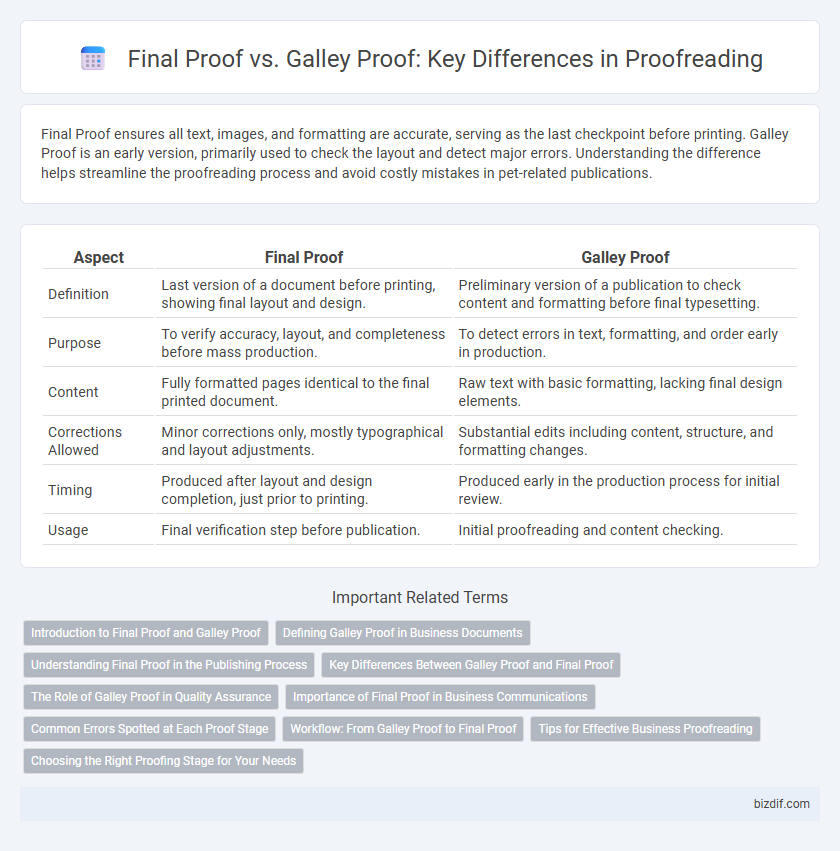Final Proof ensures all text, images, and formatting are accurate, serving as the last checkpoint before printing. Galley Proof is an early version, primarily used to check the layout and detect major errors. Understanding the difference helps streamline the proofreading process and avoid costly mistakes in pet-related publications.
Table of Comparison
| Aspect | Final Proof | Galley Proof |
|---|---|---|
| Definition | Last version of a document before printing, showing final layout and design. | Preliminary version of a publication to check content and formatting before final typesetting. |
| Purpose | To verify accuracy, layout, and completeness before mass production. | To detect errors in text, formatting, and order early in production. |
| Content | Fully formatted pages identical to the final printed document. | Raw text with basic formatting, lacking final design elements. |
| Corrections Allowed | Minor corrections only, mostly typographical and layout adjustments. | Substantial edits including content, structure, and formatting changes. |
| Timing | Produced after layout and design completion, just prior to printing. | Produced early in the production process for initial review. |
| Usage | Final verification step before publication. | Initial proofreading and content checking. |
Introduction to Final Proof and Galley Proof
Final proof represents the last version of a document before printing, ensuring all text, images, and formatting are accurate and error-free. Galley proof is an earlier stage in the printing process, primarily used to review content and layout without final adjustments. Comparing both, the final proof confirms publication readiness, while the galley proof allows for preliminary corrections and approval.
Defining Galley Proof in Business Documents
Galley proof in business documents refers to the preliminary version of a document formatted for review and correction before final printing or distribution. This stage allows for the identification and rectification of typographical, grammatical, and formatting errors, ensuring accuracy and consistency in the final product. Distinct from the final proof, the galley proof focuses on content verification and layout adjustments rather than the polished presentation of the business document.
Understanding Final Proof in the Publishing Process
Final proof in the publishing process represents the last opportunity to detect and correct errors before printing, ensuring all content, layout, and design elements are accurately finalized. It differs from galley proof, which is typically an early-stage layout focusing on text accuracy without final formatting. Understanding the role of the final proof ensures a polished and error-free publication, critical for maintaining professional standards and reader satisfaction.
Key Differences Between Galley Proof and Final Proof
Galley proof is an early version of a printed page used to check layout and content accuracy before final corrections. Final proof is the last stage, where the document is reviewed for any remaining typographical or formatting errors prior to mass printing. Key differences include the galley proof's focus on content verification and layout, while the final proof emphasizes perfection and readiness for distribution.
The Role of Galley Proof in Quality Assurance
Galley proofs play a critical role in quality assurance by providing the first complete layout for review, ensuring that formatting, typography, and content align with publishing standards before final printing. They allow editors and authors to identify and correct errors in text flow, paragraph structure, and visual presentation, preventing costly mistakes in the final proof. This proactive review process enhances accuracy and maintains consistency throughout the publication lifecycle.
Importance of Final Proof in Business Communications
The final proof is critical in business communications as it ensures the most accurate and polished version before publication, minimizing errors that could damage brand reputation. Unlike the galley proof, which primarily focuses on layout and initial content corrections, the final proof verifies all textual, formatting, and typographical elements are flawless. Thorough review during the final proof stage prevents costly misunderstandings and maintains professionalism across official documents and marketing materials.
Common Errors Spotted at Each Proof Stage
Final proofs typically reveal surface-level errors such as typos, formatting inconsistencies, and incorrect pagination, ensuring the document's appearance aligns with publishing standards. Galley proofs often highlight deeper content issues like misaligned figures, misplaced captions, and citation errors, which require thorough verification before the final print stage. Identifying and correcting errors at each stage significantly reduces costly post-publication revisions and maintains document integrity.
Workflow: From Galley Proof to Final Proof
The workflow from Galley Proof to Final Proof involves a critical review phase where textual and typographical errors are identified and corrected to ensure publication accuracy. Galley Proofs contain preliminary layouts with raw formatting, allowing editors to verify content alignment and consistency prior to producing the Final Proof. Once revisions from the Galley Proof stage are incorporated, the Final Proof serves as the definitive version for author approval and printing preparation.
Tips for Effective Business Proofreading
Final Proof ensures all textual and formatting errors are corrected before print, while Galley Proof allows early detection of layout issues and typographical mistakes. Prioritize reviewing consistency in fonts, margins, and spacing during the Galley Proof stage to prevent costly reprints. Use checklists and compare proofs meticulously for accuracy and professional presentation in the Final Proof.
Choosing the Right Proofing Stage for Your Needs
Final proof and galley proof represent critical stages in the proofreading process, with the galley proof focusing on layout and typesetting accuracy, while the final proof ensures error-free content before printing. Selecting the right proofing stage depends on project requirements, where galley proofs allow for early detection of format-related issues, and final proofs confirm textual precision after all corrections. Understanding these distinctions optimizes quality control and minimizes costly mistakes in publishing workflows.
Final Proof vs Galley Proof Infographic

 bizdif.com
bizdif.com